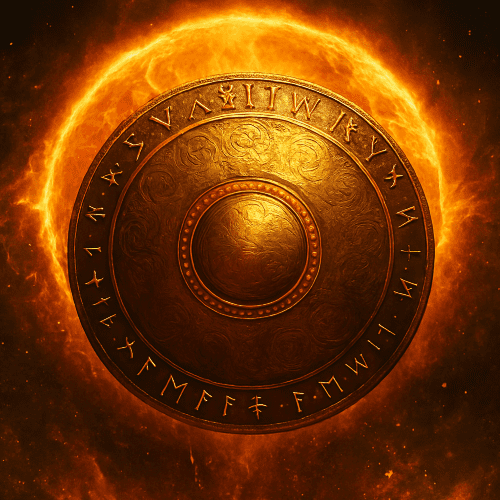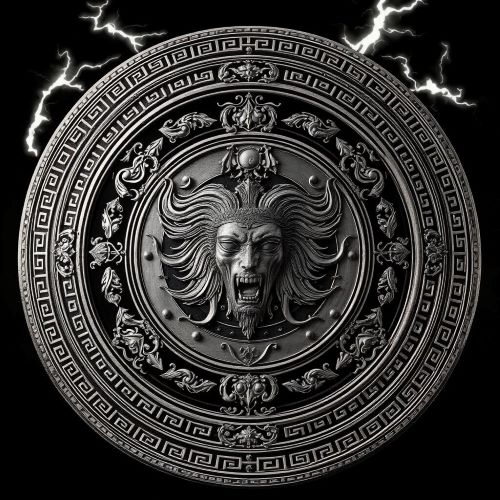Shield of Achilles: The Cosmic War-Shield
Shield of Achilles
Introduction
The Shield of Achilles stands as one of the most evocative creations in Greek mythology, immortalized through Homer’s masterful ekphrasis in the Iliad. Forged by the divine smith Hephaestus at the request of Thetis, the shield was not merely a replacement for the armor taken from Patroclus—it became a symbolic universe, crafted in metal and fire. Its elaborate imagery transforms the object from simple battlefield protection into a mythic representation of cosmic order, human life, and the tension between war and peace. Across centuries, scholars and artists have returned to its layered descriptions, finding in it a rare literary moment where craftsmanship, cosmology, and heroism converge.
Origins
The need for the shield arose after Patroclus, wearing Achilles’ original armor, was slain by Hector. Hector stripped the armor from Patroclus’ body, prompting Achilles to withdraw in grief until new divine armor could be forged. Thetis, moved by her son’s anguish, sought Hephaestus in his celestial workshop. Known for shaping the weapons of gods and heroes, the smith-god undertook the task with unmatched skill. Homer dedicates 130+ lines to the shield’s creation, emphasizing its divine origin through descriptions of molten metal, intricate etchings, and layers of bronze and precious alloys. In this moment, Hephaestus does not merely create a tool of war—he shapes an entire worldview, embedding the cosmos and human society into the shield’s concentric rings.
Think you know your myths and legends? Dive into the world of ancient stories and test your knowledge with our engaging quizzes on Mythlok!
Powers
The Shield of Achilles does not possess magical abilities in the traditional mythological sense. Instead, its power lies in its unbreakable divine craftsmanship and in the sweeping symbolism engraved upon it. The shield presents a complete panorama of existence, beginning with celestial bodies such as the sun, moon, and constellations, grounding Achilles as a warrior who carries the very order of the universe into battle. Scenes of peaceful life—weddings, celebrations, harvests, and dances—contrast with depictions of marching armies and besieged cities, illustrating the duality inherent in human experience. Through this juxtaposition, the shield becomes a philosophical artifact, reminding both hero and reader that war exists alongside the rhythms of life, and that every conflict is part of a larger cosmic cycle. Scholars have long interpreted the shield as a microcosm of the world, a symbol of divine creativity counterbalancing the destruction Achilles brings to the battlefield.
Owners/Users
In the entire Greek mythological tradition, the shield is exclusively associated with Achilles. Crafted specifically for him and attuned to the narrative of the Iliad, it was never passed down to another warrior nor reclaimed after his death. The armor Patroclus wore earlier was Achilles’ original set, not this new divine creation. While the shield’s physical form disappears from the mythological record after the Iliad, its conceptual legacy continues across cultures and eras. Later poets, from Virgil to W. H. Auden, reinterpret its imagery to reflect the moral concerns of their own time, transforming the shield into a timeless symbol of civilization’s fragility.
Instances used
The shield plays its most significant role when Achilles re-enters the Trojan War. Its gleaming surface, described as radiant as a star, becomes a visual signal of his return to the battlefield—no longer driven by honor alone, but by overwhelming grief. During his duel with Hector, the shield withstands attacks with ease, including Hector’s spear, which fails to pierce its layered metal. Its divine construction gives Achilles a defensive edge, allowing him to fulfill his destiny in the epic confrontation. Later, when he confronts the river god Scamander, the shield is not explicitly mentioned, yet the divine armor he wears undoubtedly contributes to his survival against the raging waters. These moments illustrate the shield’s protective strength while reinforcing its symbolic status as an artifact intertwined with fate, violence, and heroic destiny.
Source
Homer. (1997). The Iliad (R. Lattimore, Trans.). University of Chicago Press. (Original work published ca. 8th century BCE)
Davies, M. (2006). Shield of Achilles. In Wikipedia. Retrieved November 2025, from https://en.wikipedia.org/wiki/Shield_of_Achilles
Ancient Origins. (2021, April 11). Achilles’ Shield: What’s the Meaning of the Iliad’s Most Iconic Armor? Retrieved from https://www.ancient-origins.net/myths-legends-europe/achilles-shield-0011239
Greek Gods and Goddesses. (2022, January 10). Shield of Achilles. Retrieved from https://www.greekgodsandgoddesses.net/greek-mythology/shield-of-achilles/
GreekMythology.com. Shield of Achilles. Retrieved November 2025, from https://www.greekmythology.com/Myths/Mortals/Achilles/achilles.html
Blackwell Publishing. The Shield of Achilles. Retrieved November 2025, from https://blackwellpublishing.com
National Trust Collections. (2021). Shield of Achilles 516395. Retrieved from https://www.nationaltrustcollections.org.uk/shield-of-achilles
The Shield of Achilles. (2018, October 4). Regarding the Metaphorical Motifs on Achilles’ Shield. Retrieved from https://theshieldofachilles.net
Mythology WorldWide. (2024, November 5). The Shield of Achilles: A Look at its Legendary Power. https://mythologyworldwide.com/the-shield-of-achilles-a-look-at-its-legendary-power/
Piraino, S. (2021, April 12). Achilles’ Shield: What’s the Meaning of the Iliad’s Most Symbolic Object? Ancient Origins. https://www.ancient-origins.net/index.php/myths-legends-europe/achilles-shield-0015185
Frequently Asked Questions
What is the Shield of Achilles in Greek mythology?
The Shield of Achilles is the divine shield crafted by Hephaestus for Achilles in the Iliad, featuring detailed scenes symbolizing the cosmos and human life.
What scenes are depicted on the Shield of Achilles?
The shield includes celestial bodies, peaceful cities, cities at war, agricultural activities, celebrations, and dance—forming a microcosm of the world.
Did the Shield of Achilles have magical powers?
The shield was not magical in the sense of granting invincibility, but its divine craftsmanship made it nearly indestructible and symbolically powerful.
Who used the Shield of Achilles?
Only Achilles used the shield; it was created specifically for him after Patroclus’ death and does not appear in myths associated with any other hero.
Why is the Shield of Achilles important?
It symbolizes the balance between war and peace, human and divine order, and stands as one of the most famous examples of ekphrasis in ancient literature.








